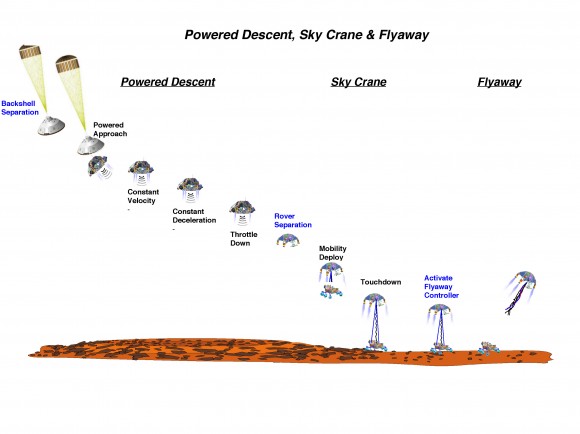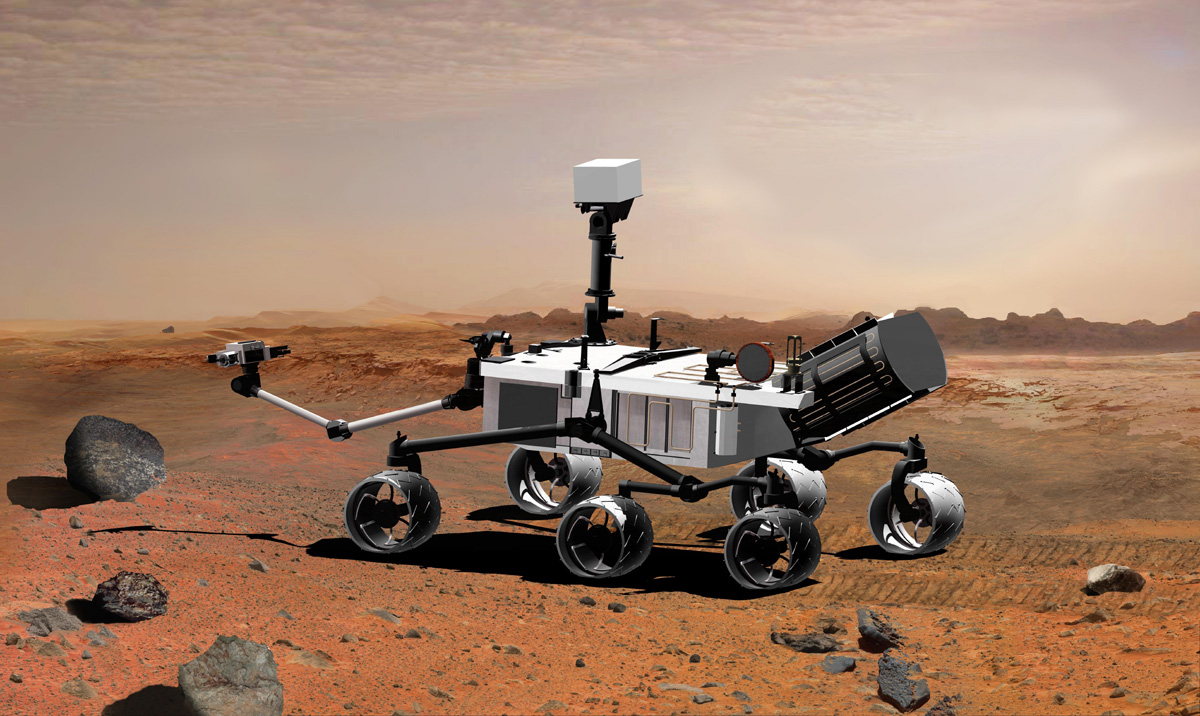[/caption]
The Mars Science Laboratory, a souped-up Mars rover scheduled to launch next year might be delayed, scaled down or canceled due to technical problems and cost overruns. The nuclear powered rover designed to search for microbial life on the Red Planet, has already cost $1.5 billion and if it reaches a 30-percent cost overrun, it could be cancelled by Congress. Aviation Week reports that officials from the agency’s Mars Exploration Program (MEP) and the Jet Propulsion Laboratory (JPL) will brief NASA Administrator Mike Griffin and Science Associate Administrator Ed Weiler this Friday and attempt to work out a potential solution. Delaying the rover’s mission until 2011 would be costly, but Weiler has said that JPL is so stretched trying to make the 2009 launch window that the result could be “a nuclear crater on Mars.”
Nearly the size of a small car, the proposed MSL will be three times as heavy and twice the width of the Mars Exploration Rovers (MERs) that landed in 2004, and will be able to travel twice as far. It will carry ten advanced scientific instruments and cameras. It will make the first precise landing and a predetermined site, using a guided entry system and a soft-landing system called the Sky Crane. But assembly and testing of critical components and instruments are behind schedule because of technical problems.

Since there’s not much extra cash anywhere in NASA and JPL’s pot, any cost overruns from technical issues or delays would have to be taken from other missions. To keep MSL, NASA could be forced to cancel the $485 million 2013 atmospheric Scout mission MAVEN that was recently announced, or a future rover mission tentatively set for 2016.
A slip to the 2011 launch window will add another $300 million-$400 million to the price tag, but it could be better than trying to launch in 2009 with a rover and team that is potentially unready to fly.
Doug McCuistion, the MEP manager said his program is stretched to its limits, with no funding for technology development and “next to nothing” for education and public outreach.
NASA has been sending a mission to Mars approximately every two years to determine if the planet ever was capable of supporting life.
Sources: Aviation Week, MSNBC


Who here doesn’t think MSL won’t have a snowball’s chance in hell of making it through Congress the way things are financially right now?
I have also had a bad feeling about the whole project, the way they pushed such a big craft with new and basically untried technologies trying to get it off the planet next year. They may be doing Mars exploration a big favor by getting rid of it.
ESA has also scaled back its own similar rover. The Russians learned the hard way about a really expensive Mars sample return mission in the 70s when they tried to build one to one up the Viking landers and it ended up crippling their own Mars program.
Maybe we should wait for manned missions before trying to get surface samples back to Earth.
I disagree. MSL is the next logical step in our journey to Mars. We have to learn how to land heavy cargo on the surface where we want them if the current human mission plans are to work.
NASA’s past missions have been a steady progression of capability. Pathfinder validated the airbag landing technique and the proof-of-concept rover. Spirit and Opportunity were the fruits of that first mission. The next step was Mars Polar Lander. MPL validated the automated power decent technique through an atmosphere and a much tighter landing ellipse than their other landers. The next logical step is to use those techniques in the MSL.
Last I heard, NASA doesn’t know how to land anything much larger than MSL on Mars. That problem needs to be solved before humans are sent. The current plan to reduce the landing weight is to send the return vehicle before the crew. NASA needs to figure out how to land where they want if they want the crew to be able to reach their ride home.
I also disagree that they should wait till the human missions to return a sample. That sample return could be the technology test that precedes the human missions. First, place a lander on the surface with the fuel manufacturing plant and the return vehicle. Then follow it up with a second mission to land a rover near the return vehicle. The rover collects the samples and transfer’s them to the return vehicle. This kind of mission would be much cheaper, easier and safer than waiting till humans step foot on the planet.
However, I do agree that MSL is in real trouble. Cost overruns will kill the project if they can’t get them under control. The current financial debacle we find ourselves in only make it harder to justify a science mission three years down the road when elections are two months down the road. It is a shame that cutting edge science is so easily cut for political reasons.
Just makes me sad… USA throws over 700 billions for military this year and then it’s cutting all important research…
Do they really want to go back to that what happen 10 years ago? The idea of going cheap, fast etc… What a disaster…
I guess NASA should really “find” oil from Mars… Then we would have 20 countries trying to fly there in few weeks….
This is an epic disaster. This is clearly the most important Mars surface mission of all time, with the biggest potential payoffs. Though there is no direct link between NASA funding and the most recent financial disaster to come out of the states, I blame wall street. F$$k you Wall $treet! Can these bastards go 10 years without bringing the world economy to its knees? Obviously not. Morons.
However, if this is not solely a funding issue – if there is real danger of the mission not being 100% ready in the eyes of the flight engineers, then it should certainly be postponed. Not scaled back – just delayed. Better to get it right in three years time than to create an expensive new crater in the Martian surface. That would send public opinion and that of congress concerning the space program into a nose dive. Couple that with a relatively fresh president looking to score political points with the majority of Americans on economic and fiscal responsibility, and we may not have many Mars missions flying in the foreseeable future…
That’s why they are in Mars 😀 …to find oil. But I guess the gov’t is risking it, so budget prolly has to go somewhere.
If oil is found, NASA will prolly have massive budget backings from major private oil companies 😀 .
Someone sneak in and slip out that China are going to Mars to find life… boom, 2nd space race.
But seriously, this really is pretty terrible…
I am in 2 sides with this though, one side says it is alright, because life down here is more important than life out there, and what exactly will it do when they DO find life?
The other half is saddened by the lack of interest in space these days… sad days indeed.
Don’t get me wrong I love space exploration. But I could careless if they found dead *life* on mars. If the topic of the mission was to highlight a cover topic that was a tad more interesting, I’m more than certain congress wouldn’t reject it.
Say if one of the experiments were to somehow obviously relate back to the expansion of human control, then we might be getting more funding for this.
Its like how could you reject the “Patriot” Act?
MSL is a logical step in the exploration of Mars, but it should not be the NEXT one. Or at least not so soon.
I am genuinely concerned that this one is going to join Mars Polar Lander as so much metal debris in the dust – and with a nuclear reactor to boot! I am amazed the anti-nuke nuts haven’t flipped out about this yet like they did with Cassini ten years ago.
As for returning samples of the planet, a robot mission will only return a few pounds from one place at most, just like the Soviet Luna probes did in the early 1970s. Apollo by contrast returned almost 500 pounds from 5 different places.
I also think if we send humans to Mars we should start right off with beginning a permanent colony. Otherwise we could have that feat vanish like Apollo did in 1972.
Maybe it’s time to start learning Chinese.
not surprising. nasa is always one of the first on the chopping block. even though projects might be cut back, the community can still at least work on advancing theory until the sunshine comes out again.
First of all, oil, or what looks like it is clearly visible on the surface. But you cannot argue for a drop in that area as without prior survey, you could lose the mission by simply sinking into whatever is there.
The enormous financial losses of Wall Street show that investing in “paper” now carries great risk. We need to open a dialogue with savings institutions to show that money “spent” on space remains here on the planet and has much greater usefulness, as an investment into the community than bits of paper.
Next, I continue to push for a vehicle to be dropped into the deepest sunlit valley we can find. You only need to look at a summer picture of such valleys here on earth to see the ice on the mountain tops and grass at the valley bottom to get an idea of the future potential.
Instead of NASA complaining to government about funding, it needs to open that dialogue with finance outside of government. Until they do, everything science is trying to do is going to be moot for at least the next decade.
It’s cute to wish for oil on Mars, but even if the whole planet were covered with it miles deep, the cost to get it back to Earth would be ridiculous.
But don’t tell Dubya and just maybe….
Remember when astronomers speculated that Venus was covered in a global ocean of oil in the 1950s? On the other hand, Titan is covered in materials that might actually make a good fuel. And we have all those comets with water ice. Plus I read that one typical asteroid has enough nickel in it to meet our needs for the metal for centuries.
But we need a space infrastructure to get it all first.
I’ll do it for 1.4 billion !